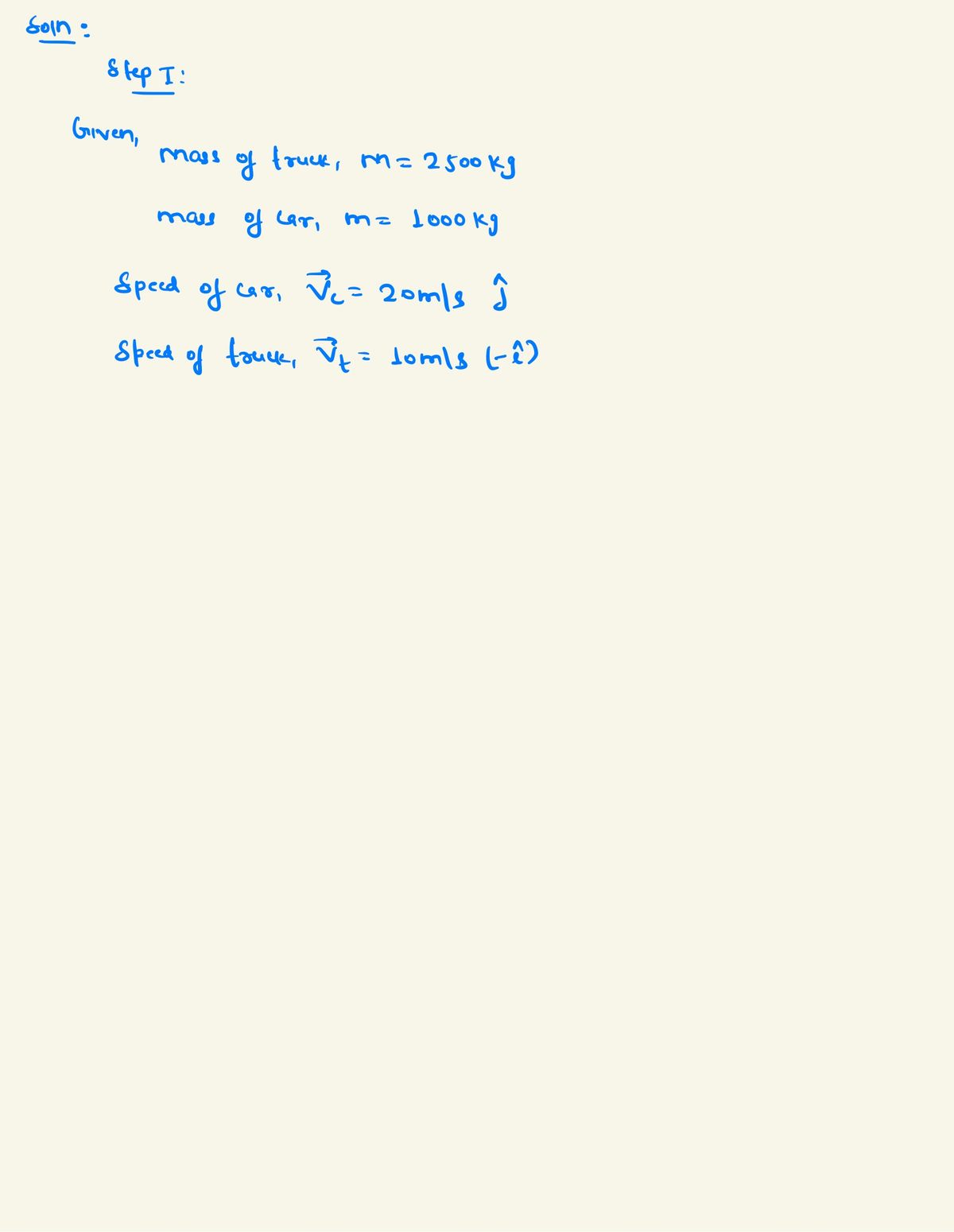A truck (M = 2500kg) collides with a car (m = 1000kg) at a 4-way intersection. Fortunately nobody gets hurt. Suppose the car is going north at 20m/s ( about 45mph) and the truck is coming from the east at 10m/s ( about 22mph). The car and truck stick together after the collision. (a) Find the speed and direction of the car and truck immediately after the collision. (b) Approximately how much energy went into the deformation of the metal that caused the two vehicles to stick together? (c) What assumptions did you make?
A truck (M = 2500kg) collides with a car (m = 1000kg) at a 4-way intersection. Fortunately nobody gets hurt. Suppose the car is going north at 20m/s ( about 45mph) and the truck is coming from the east at 10m/s ( about 22mph). The car and truck stick together after the collision. (a) Find the speed and direction of the car and truck immediately after the collision. (b) Approximately how much energy went into the deformation of the metal that caused the two vehicles to stick together? (c) What assumptions did you make?
College Physics
11th Edition
ISBN:9781305952300
Author:Raymond A. Serway, Chris Vuille
Publisher:Raymond A. Serway, Chris Vuille
Chapter1: Units, Trigonometry. And Vectors
Section: Chapter Questions
Problem 1CQ: Estimate the order of magnitude of the length, in meters, of each of the following; (a) a mouse, (b)...
Related questions
Question

Transcribed Image Text:**Constants and Other Possibly Useful Numbers**
- **g = 9.8 m/s²**: Acceleration due to gravity.
- **G = 6.67 × 10⁻¹¹ Nm²/kg²**: Universal gravitational constant.
- **c = 3 × 10⁸ m/s**: Speed of light.
**Masses and Radii**
- **Mass of an electron (mₑ)**: 9.11 × 10⁻³¹ kg
- **Mass of a proton (mₚ)**: 1.67 × 10⁻²⁷ kg
- **Mass of Earth**: 6 × 10²⁴ kg
- **Radius of Earth**: 6.4 × 10⁶ m
- **Mass of the Moon**: 7.35 × 10²² kg
- **Radius of the Moon**: 1.74 × 10⁶ m
- **Mass of the Sun**: 2 × 10³⁰ kg
- **Radius of the Sun**: 6.957 × 10⁸ m
**Average Distances**
- **Between the Moon and Earth**: 3.84 × 10⁸ m
- **Between the Sun and Earth**: 1.5 × 10¹¹ m
**Moments of Inertia**
- **General Formulation**: \( I = \sum m_i r_i^2 \)
- **Ring**: \( I_{\text{ring}} = M \left( \frac{R_1^2 + R_2^2}{2} \right) \)
- **Disk/Cylinder**: \( I_{\text{disk}} = I_{\text{cylinder}} = \frac{1}{2} MR^2 \)
- **Rod**: \( I_{\text{rod}} = \frac{1}{12} ML^2 \)
- **Sphere**: \( I_{\text{sphere}} = \frac{2}{5} MR^2 \)
**Vector Products**
The vector product or cross product between two vectors **A** and **B** can be calculated as follows:
If you know the angle \( \theta \) between the two vectors, find the magnitude of the product \( | \mathbf{C} | = | \mathbf{A} \times \

Transcribed Image Text:**Collision Problem at a 4-Way Intersection**
A truck (\(M = 2500 \text{kg}\)) collides with a car (\(m = 1000 \text{kg}\)) at a 4-way intersection. Fortunately, nobody gets hurt. Suppose the car is moving north at 20 m/s (approximately 45 mph), and the truck is traveling from the east at 10 m/s (approximately 22 mph). After the collision, the car and the truck stick together.
### Questions:
(a) Determine the speed and direction of the car and truck immediately after the collision.
(b) Estimate the amount of energy that was converted into the deformation of the metal, causing the two vehicles to stick together.
(c) What assumptions were made in this scenario?
---
This exercise is designed to help you understand the principles of momentum and energy conservation in collisions.
Expert Solution
Step 1

Step by step
Solved in 2 steps with 2 images

Recommended textbooks for you

College Physics
Physics
ISBN:
9781305952300
Author:
Raymond A. Serway, Chris Vuille
Publisher:
Cengage Learning

University Physics (14th Edition)
Physics
ISBN:
9780133969290
Author:
Hugh D. Young, Roger A. Freedman
Publisher:
PEARSON

Introduction To Quantum Mechanics
Physics
ISBN:
9781107189638
Author:
Griffiths, David J., Schroeter, Darrell F.
Publisher:
Cambridge University Press

College Physics
Physics
ISBN:
9781305952300
Author:
Raymond A. Serway, Chris Vuille
Publisher:
Cengage Learning

University Physics (14th Edition)
Physics
ISBN:
9780133969290
Author:
Hugh D. Young, Roger A. Freedman
Publisher:
PEARSON

Introduction To Quantum Mechanics
Physics
ISBN:
9781107189638
Author:
Griffiths, David J., Schroeter, Darrell F.
Publisher:
Cambridge University Press

Physics for Scientists and Engineers
Physics
ISBN:
9781337553278
Author:
Raymond A. Serway, John W. Jewett
Publisher:
Cengage Learning

Lecture- Tutorials for Introductory Astronomy
Physics
ISBN:
9780321820464
Author:
Edward E. Prather, Tim P. Slater, Jeff P. Adams, Gina Brissenden
Publisher:
Addison-Wesley

College Physics: A Strategic Approach (4th Editio…
Physics
ISBN:
9780134609034
Author:
Randall D. Knight (Professor Emeritus), Brian Jones, Stuart Field
Publisher:
PEARSON